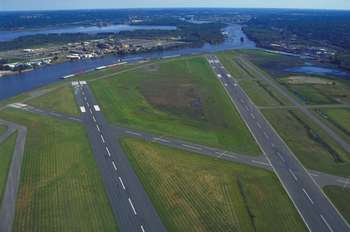Heavy turbulence: MACs draft zoning for Holman Field lands with a thud in St. Paul

The Mississippi River wraps around the edge of the Holman Field Airport.
Photo: Metropolitan Design Center Image Bank,
© Regents of the University of Minnesota. All rights reserved. Used with permission.
New draft zoning from the Metropolitan Airports Commission (MAC) around St. Pauls Holman Field has drawn widespread rebuke from community members. Under the proposal, river vegetation, bird habitat, and a key interpretive project could fall victim to stringent new safety requirements of the nearby airport.
While a decades-old state law requires a new zoning code of some sort be adopted for Holman Field, theres much room for debate and disagreement about exactly how to proceed. At a July 23rd hearing on the proposed zoning, community members found the agency to seem painfully out of touch with its place in the community. Several key concerns have become flashpoints in the discussion.
The proposed restrictions would substantially restrict habitat, particularly for birds in the area. Since time immemorial, the Mississippi River corridor has been one of the most important migratory flyways on the continent. The corridor has been given a special status to protect its wildlife, including particularly avian life. The Bruce Vento Nature Sanctuary was established earlier this decade in the lands nearby to protect bird habitat and other wildlife.
But the Sanctuary, along with many other parts of the river valley, are dramatically restricted by the draft ordinance. The too-vague draft would broadly prohibit ponds or other uses that might attract waterfowl or other birds. And one other use that would certainly attract waterfowl or birds is the river itself.
Just in advance of a July 23rd hearing, MAC officials revealed they had recently captured and transported two bald eagles elsewhere when they deemed they were nesting too close to the airport. That drew strong displeasure from some. To relocate bald eagles and other species, which are symbols of our country and have really become a destination for visitors in downtown St. Paul, urges reconsideration, said Andrew Schlack, representing downtowns CapitolRiver Council.
Severe height restrictions represent another troubling direction in the proposed ordinance. It would make existing trees over a certain height non-conforming, and thus eligible for partial removal. Much of the Vento Sanctuary, for example, could only have trees of 40 feet or less, significantly less than one would expect many native tree species to grow. The nearby Swede Hollow natural area would see height limits of 20 feet. Still other areas could have no trees or vegetation whatsoever.
Finally, height limits could also limit City plans to renovate an old rail depot alongside the Vento Sanctuary bluff into an interpretive center. The City of St. Paul recently purchased the four-story rail depot and surrounding site, but are concerned the new height restrictions could limit what could be done on the site.
Understandably, the MACs proposed restrictions have drawn uniform and unrelenting criticism from stakeholders. While similar restrictions are in effect around MSP, the context of that airport is completely different. It handles far more traffic as the regions principal airport, is on top of a bluff rather than in a river valley, and is located in an area far from either downtown.
Other aspects of the proposal have provoked more than a few dropped-jaws. The height of new buildings in downtown St. Paul would be limited to 80 feet (St. Pauls skyline reaches as high as 471 feet). The only way around that would be with a variance from the MAC. Limits would be placed on vegetation on the Capitol Grounds nearly a mile away from the airport itself.
A July 23rd hearing drew concern from a wide variety of parties, including the St. Paul Port Authority, St. Paul Building Owners and Managers Association, the Audubon Society, and the City of St. Paul itself.
Were not sure this meets the reasonableness test, said St. Paul City staff Al Lovejoy. Lovejoy is part of an appointed Joint Airport Zoning Board that includes representatives of local cities, as well as the MAC. The Board will take the considerable comments and says they will work to update the zoning.
But if the uniformity of opposition to the zoning is any indication, the MAC Board will have an uphill road.
State Representative Sheldon Johnson summed peoples feelings up uncharacteristically bluntly: "[The MAC] and the airport need to figure out their place in the bigger community rather than expecting the community to constantly figure out what they need to do to fit the airport.